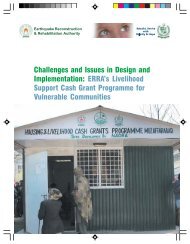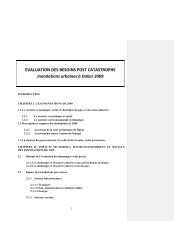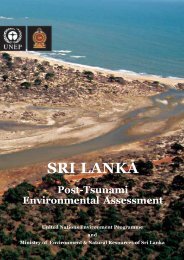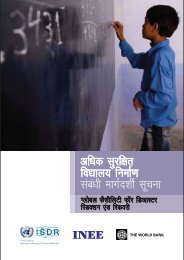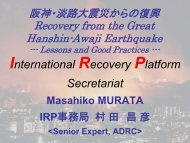Multifunctional Structures - World Bank Institute
Multifunctional Structures - World Bank Institute
Multifunctional Structures - World Bank Institute
You also want an ePaper? Increase the reach of your titles
YUMPU automatically turns print PDFs into web optimized ePapers that Google loves.
KNOWLEDGE NOTE 1-4<br />
CLUSTER 1: Structural Measures<br />
<strong>Multifunctional</strong> <strong>Structures</strong><br />
<strong>Multifunctional</strong> <strong>Structures</strong><br />
1
Prepared by Junko Sagara, CTI Engineering<br />
2 KNOWLEDGE NOTE 1-4
KNOWLEDGE NOTE 1-4<br />
CLUSTER 1: Structural Measures<br />
<strong>Multifunctional</strong> <strong>Structures</strong><br />
Public facilities and infrastructure can be built in such a way as to reduce disaster<br />
risks and serve as disaster risk management facilities. Roads, expressways, and<br />
other public facilities helped reduce damage and loss in the Great East Japan Earthquake<br />
by providing protection against flooding, and by serving as evacuation routes<br />
and base stations for emergency operations. Organizations for disaster management<br />
and other public sector organizations should coordinate to ensure that their public<br />
works are multifunctional whenever possible; and cost-sharing mechanism should<br />
be developed to ensure that the financial burden is shared equitably.<br />
FINDINGS<br />
Expressways served as disaster management facilities<br />
Expressways and roads mitigated damage resulting from the Great East Japan Earthquake<br />
(GEJE). The East Sendai Expressway, a 24.8-kilometer toll road running through the Sendai<br />
Plain, about 4 kilometers off the coast and at an elevation of 7 to 10 meters, acted as a<br />
secondary barrier or dike and prevented tsunamis from penetrating further inland (figure 1).<br />
It also prevented debris from flowing into the inland urban areas. The embankment served<br />
as an evacuation shelter for nearby residents, and about 230 people escaped the tsunami<br />
by running up to the expressway.<br />
Many expressways were built on high ground, providing routes for evacuation as well as<br />
for rescue operations. Many coastal towns and communities were isolated immediately<br />
after the disaster because roads were flooded or covered with debris. Expressways built<br />
on higher ground served to connect otherwise isolated towns and communities (figure 2).<br />
The Sanriku Expressway, a 224-kilometer expressway that runs along the Pacific coast<br />
through the Miyagi and Iwate prefectures, is still under construction. About 51 percent of<br />
the expressway was open for public use when the area was hit by the GEJE; it helped save<br />
many lives.<br />
<strong>Multifunctional</strong> <strong>Structures</strong><br />
3
FIGURE 1: East Sendai Expressway<br />
Source: MLIT.<br />
4 KNOWLEDGE NOTE 1-4
FIGURE 2: The Sanriku Expressway was built with tsunamis in mind<br />
Source: MLIT.<br />
Expressways constructed on higher ground were not damaged by the tsunami. In the aftermath<br />
of the GEJE, they provided an evacuation route for residents and enabled the selfdefense<br />
forces and other emergency relief teams to get to the coastal municipalities that<br />
had been heavily affected. It also served as an important emergency route for transporting<br />
food, medical supplies, fuel, and other relief materials going to local disaster management<br />
bases and evacuation centers.<br />
Miyako Road, a 4.8-kilometer section of the Sanriku Expressway, opened in March 2010.<br />
When the tsunami hit the area, about 60 residents managed to escape from the tsunami by<br />
climbing up the expressway embankment.<br />
The Kamaishi–Yamada Road, a 23-kilometer section of the Sanriku Expressway that was<br />
opened only six days before the GEJE, served as a disaster management road. It was built to<br />
ease traffic congestion on Route 45, the main road connecting the coastal communities. Since<br />
Route 45 was prone to flooding from typhoons and tsunamis, the new road was expected<br />
to provide an alternative route if Route 45 were cut off in an emergency. In the Unosumai<br />
District of Kamaichi City, about 570 residents and school children escaped the tsunami.<br />
Because the road that led to the evacuation shelter had been destroyed, they climbed up to<br />
the Kamaishi-Yamada Road and managed to reach the evacuation shelter safely.<br />
Service stations and parking areas along highways served as<br />
disaster management bases<br />
Roadside service stations, service areas, and parking areas along highways also helped in<br />
the disaster management effort, providing bases of operation for rescue teams and evacuation<br />
shelters for local residents (table 1). The roadside service stations and rest areas along<br />
roads and highways, called Michi-no-eki (road stations), are equipped with toilets, restau-<br />
<strong>Multifunctional</strong> <strong>Structures</strong><br />
5
TABLE 1: “Road stations” used in the aftermath of the GEJE<br />
Road stations Location Services during GEJE<br />
Sanbongi Osaki, Miyagi Open for 24 hours with power.<br />
Supplied food to evacuees.<br />
Tsuyama Tome, Miyagi Used as a base for self-defense<br />
forces and rescue teams and as<br />
an evacuation center.<br />
Fukushima-Touwa<br />
Nihonmatsu,<br />
Fukushima<br />
Provided food, water, and toilets<br />
for evacuees. Used by 1,500<br />
evacuees.<br />
Kita-no-sato Kitakata, Fukushima Provided water and food.<br />
Minamisouma<br />
Minamisouma,<br />
Fukshima<br />
The hot-spring facility was<br />
made available to the affected<br />
residents.<br />
Used as an evacuation center<br />
and emergency support base.<br />
Hirata Hirata, Fukushima Provided power and water to<br />
evacuees and food to local<br />
hospitals and evacuation centers.<br />
FIGURE 4: Self-defense force at a roadside station<br />
Source: MLIT.<br />
rants, and shops and are also intended to promote local tourism and business. These facilities<br />
are developed jointly by the Ministry of Land, Infrastructure, Transport, and Tourism<br />
(MLIT) in cooperation with local municipalities. In April 2012, there were 987 such stations<br />
nationwide. During the GEJE road stations were turned into disaster management bases<br />
equipped with electric power. They were available to the public around the clock when the<br />
neighboring area experienced power failures (figure 4).<br />
6 KNOWLEDGE NOTE 1-4
FIGURE 5: Evacuation stairway at the Omoto Elementary School<br />
Source: MLIT.<br />
In Minami Sanriku City, sports facilities near a highway exit were used as a disaster<br />
management center, evacuation shelter, drop-off site for emergency supplies, and operating<br />
base for the local government, medical institutions, police, and volunteer workers.<br />
The local government even moved its office to the site, because its official building had<br />
been destroyed by the tsunami.<br />
Evacuation stairs to expressways saved school children<br />
When Iwaizumi Town in the Iwate Prefecture was severely hit by the massive tsunami, an<br />
evacuation stairway constructed at the Omoto Elementary School two years before saved<br />
the lives of 88 children (figure 5). Because there was no escape route from the school,<br />
since it was surrounded by steep cliffs, some of the children, during a tsunami evacuation<br />
drill, suggested how improvements might be made. In response to their suggestions and<br />
those of local residents, a MLIT field office completed the approximately 30-meter evacuation<br />
stairway with 130 steps along Route 45, which runs right behind the school.<br />
LESSONS<br />
Embankment structures used to raise the elevation of highways and expressways can<br />
effectively prevent penetration of tsunami water and debris further inland. They can also<br />
be used as disaster management facilities (box 1).<br />
Roads, highways, and expressways provided safe evacuation sites and escape routes<br />
because they were designed with earthquakes and tsunamis in mind. It pays to take<br />
disaster reduction into account when designing transport and other infrastructure.<br />
Public facilities such as roadside stations and highway parking areas were used by various<br />
teams and organizations as base stations for rescue and emergency operations. They were<br />
<strong>Multifunctional</strong> <strong>Structures</strong><br />
7
BOX 1: Evacuation stairs to the East Sendai Expressway<br />
Recognizing that the embankment of the East Sendai<br />
Expressway had served acted as an effective evacuation site<br />
for local residents, evacuation stairs were temporarily installed<br />
at five locations along the embankment in May 2011. They are<br />
intended to facilitate evacuation in case of a tsunami.<br />
Source: MLIT.<br />
also used as evacuation centers because they were equipped with electricity, food, and<br />
water supplies.<br />
RECOMMENDATIONS FOR DEVELOPING COUNTRIES<br />
Infrastructure and public facilities such as roads, highways, and railways can be used as<br />
disaster management facilities in the event of floods, tsunamis, mudflows, and landslides.<br />
Facilities that are multifunctional are a particularly cost-effective approach to disaster<br />
management.<br />
Integrate various facilities into planning for disaster risk management. DRM plans<br />
should include a range of public facilities. For example, playgrounds and parking areas can<br />
become rescue team bases or spaces for transition shelters. Expressway embankments<br />
can become evacuation sites in the event of cyclones, floods, and tsunamis.<br />
Develop cost-sharing mechanisms. Cost-sharing mechanisms should be established<br />
between DRM organizations and public works organizations. The latter cannot be expected<br />
to bear all the DRM-related costs of a project, since those costs affect the project’s financial<br />
feasibility. In Japan the cost of adding height to an expressway is shared by the DRM<br />
organizations (KN 2-3-1).<br />
Coordinate with other sectors. Coordination with other sectors, such as transportation,<br />
is required to develop multifunctional facilities. Platforms to coordinate planning, construction,<br />
and operation and maintenance should be established. In Japan prefectural governors<br />
designate the multifunctional facilities, allowing concerned organizations to initiate coordination<br />
under a new tsunami DRM law (KN 1-3).<br />
Consider negative effects. High structures such as bridges and highways may have negative<br />
effects, such as water logging. They may isolate or separate communities and impose<br />
obstacles to the passage of people and animals. These effects should be assessed, and<br />
countermeasures or diversion channels and routes developed. In Japan, permission from<br />
DRM organizations is required before highways and bridges can be built.<br />
8 KNOWLEDGE NOTE 1-4
KEY REFERENCES<br />
Okumura, Y. 2011. Efforts in the Great East Japan Earthquake of the Ministry of Land,<br />
Infrastructure, Transport, and Tourism (Higashinihon daishinsai deno torikumi) (in Japanese).<br />
http://www.jari.or.jp/resource/uploads/Symposium2012-01.pdf<br />
Shikoku Regional Development Bureau, MLIT. 2011. Lessons of the Great East Japan<br />
Earthquake (Higashinihon daishinsai kara manabu mono) (in Japanese). http://www.<br />
skr.mlit.go.jp/kikaku/senryaku/pdf/1-kaigi/110609%E3%80%80siryou-1.pdf<br />
Tohoku Regional Development Bureau, MLIT. 2011. Efforts during the Great East Japan<br />
Earthquake (Higashinihon daishinsa no taiou ni tsuite) (in Japanese). http://www.thr.<br />
mlit.go.jp/road/ir/shouiinkai/pdf/110825/03_siryou1.pdf<br />
MLIT. 2011. Cases Where <strong>Structures</strong> Provided Added Functions during the Great East Japan<br />
Earthquake (Higashinihon daishinsai ni oite fukujiteki na bousaikinou wo hakkishita jirei)<br />
(in Japanese). http://www.mlit.go.jp/road/ir/ir-council/hw_arikata/teigen/t01_data04.pdf<br />
<strong>Multifunctional</strong> <strong>Structures</strong><br />
9





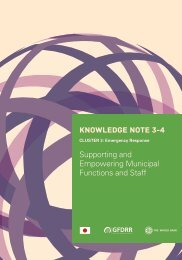
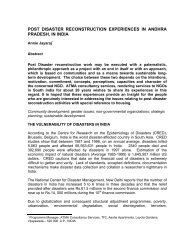
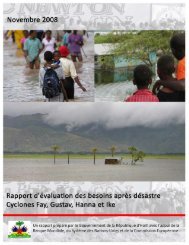
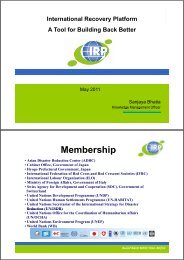
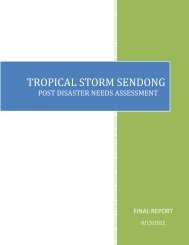
![View full document [PDF 7.65 MB] - unisdr](https://img.yumpu.com/48902806/1/178x260/view-full-document-pdf-765-mb-unisdr.jpg?quality=85)
